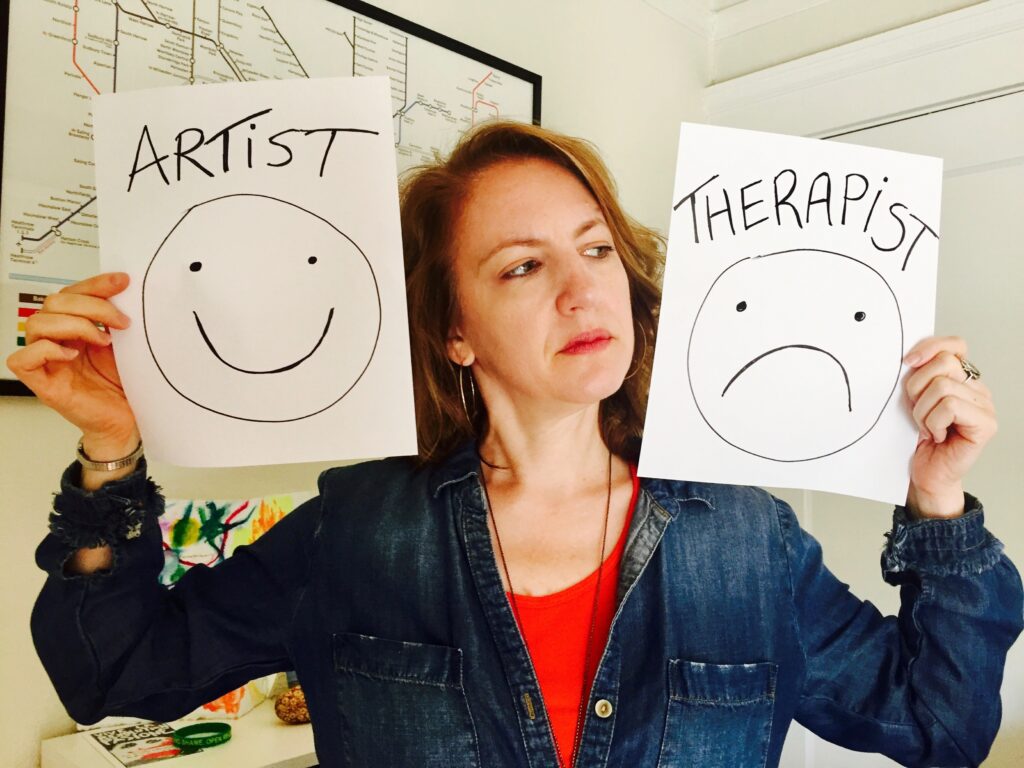Artist or Therapist? My Dilemma

Sometimes being an arts therapist doesn’t feel very cool. The label of therapist can make me feel uninteresting and irrelevant. It can feel like wearing a conservative outfit, being invisible and blending into the background. Sometimes in social settings I have seen people get nervous around me when I identify as a ‘therapist’. I’m guessing that they think I might be analyzing them or reading their insides. Or they might start opening up about their deep pain and struggles imagining I will take some of the burden away. Either way, my impulse is to take up less space. When I was younger and starting my study of expressive arts therapy (which I define as an interdisciplinary arts approach to healing), I relished the idea of being a healer/therapist. The role seemed very mature and important, yet I was insecure and didn’t feel I had the confidence or life experience for people to take me seriously. It took years to meet this role and fully own it. And, now much more seasoned, I find myself rejecting the therapist label. Instead, I want the expanding title of artist. Yeah, that feels better.
Being an artist sounds slick and feels edgy. For me, the artist role helps me to defy norms, push against boundaries, challenge people and ideas and be ‘selfish’. I don’t have to play it safe, or worry about people’s feelings. My artist self was birthed much earlier than my therapist self. It emerged in adolescence when I started taking photographs, exploring my own internal world expressed through imagery, and being an artist allowed me to feel free and special. Art felt like a dive into something unknown and risky. Francis Ford Coppola said this in an interview, “An essential element of any art is risk. If you don’t take a risk then how are you going to make something really beautiful, that hasn’t been seen before? I always like to say that cinema without risk is like having no sex and expecting to have a baby. You have to take a risk.”
A therapist is defined as someone whose job is to help people while an artist’s job is to produce. Like most things, society has expectations about these roles. You could say that a therapist is serious and needs to be organized, supportive and calm, while an artist is more playful and/or wild, and also allowed to be messy, unpredictable and even unlikable. This may or may not be true, but often it is a matter of perception. And, I can impose these expectations on myself – hence the dilemma.
Here is the good news for me (and maybe for you too): I don’t have to conform to these concepts or the fears that run through my head about how people are viewing me. And, I can also re-define art and therapy for myself and continue to blend them in my work. In other words, I can be creative as a therapist by pushing boundaries and encouraging people to take risks. I can also provide safety as an artist, be human and community-minded. I believe that this is the purpose of art, and increasingly, artists and therapists both play an important role in today’s world if they are willing to step up to the challenge. The writer Maria Popova agrees, “This is the power of art: The power to transcend our own self-interest, our solipsistic zoom-lens on life, and relate to the world and each other with more integrity, more curiosity, more wholeheartedness.” A colleague of mine who is a socially active psychotherapist, Traci Ruble, often helps me think bigger. This one is for you Traci. I’m a badass artist therapist. Deal with it.
Self-Published May 10, 2017
Photograph by Mitch Ryder